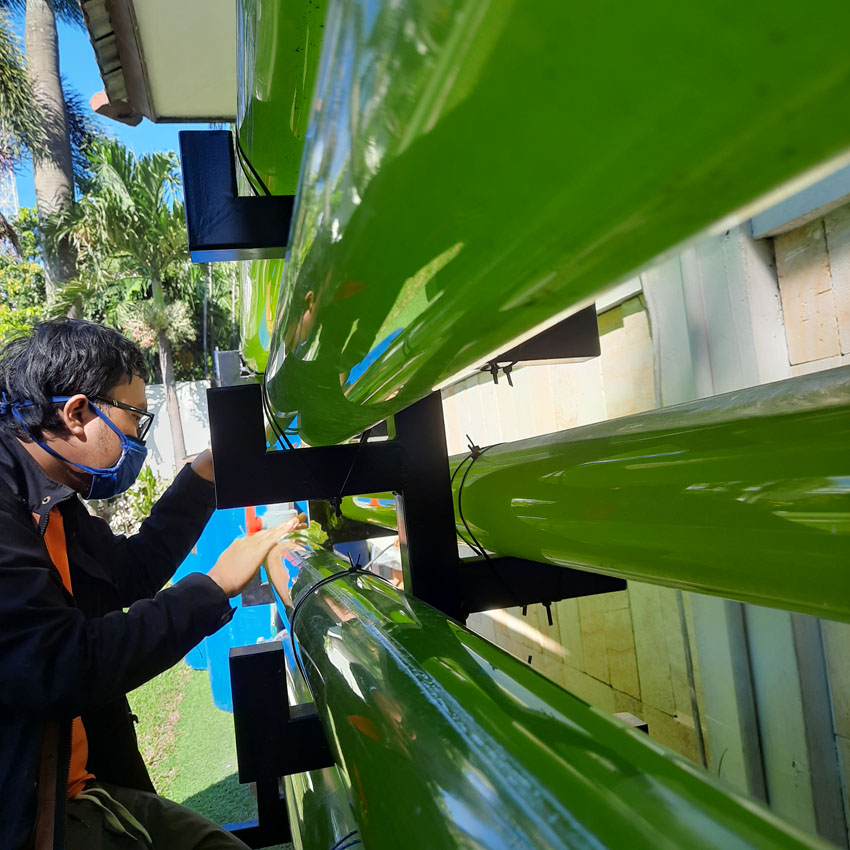


MICROALGAE FARM
Microalgae include both cyanobacteria, (similar to bacteria, and formerly called “blue-green algae”) as well as green, brown and red algae. (There are more varieties of microalgae, but these are the most significant in algae agriculture.). Spirulina is a cyanobacteria (blue-green algae) that can be consumed by humans and animals.
Microalgae can be cultivated in a variety of ways. Most microalgae grow through photosynthesis – by converting sunlight, CO2 and a few nutrients, including nitrogen and phosphorous, into material known as biomass.
ALBITEC production technologies are currently used in commercial applications as well as research. These open ponds with Continous Cultivation. Simply put, there is no one single way to grow algae.
Ready to know into the knowledge of on all things Microalgae? Follow us @albitec.id
Continuous
Cultivation
PT. Alga Bioteknologi Indonesia menggunakan continuous cultivation agar pertumbuhan alga maksimal sehingga kondisi kultur tetap terjaga.


Carbon Capture
Microalgae
Microalgae could be one of the most promising carbon capture and Climate Change solutions. Growing one ton of algae can capture nearly two tons of carbon dioxide, while using this biomass to make products or biofuels can also help reduce greenhouse gas emissions. The carbon impact of algae-based biofuels, for example, can be up to 70% better than fossil fuels.
Algae fuel will have a significant energy return on investment, consume waste CO2 and can be grown in saltwater on marginal lands






DEVINITY

INNOVATION

AGILITY

INTEGRITY

RESPECT
OUR FOUNDER
The leadership of the Algae Biotechnology Indonesia is critical industry to move forward towards commercialization.

Falasifah - Director of ALBITEC
OUR HISTORY
Today’s Invesment, Tomorrow’s Impact
The Alga Biotechnology Indonesia is microalgae industry forward as the next generation of algae cultivation and biotechnology continues to advance and creates more opportunities.
Albitec 2020. All Right Reserved

MICROALGAE FARM
Microalgae include both cyanobacteria, (similar to bacteria, and formerly called “blue-green algae”) as well as green, brown and red algae. (There are more varieties of microalgae, but these are the most significant in algae agriculture.).
Spirulina is a cyanobacteria (blue-green algae) that can be consumed by humans and animals. Microalgae can be cultivated in a variety of ways. Most microalgae grow through photosynthesis – by converting sunlight, CO2 and a few nutrients, including nitrogen and phosphorous, into material known as biomass.
ALBITEC production technologies are currently used in commercial applications as well as research. These open ponds with Continous Cultivation.
Simply put, there is no one single way to grow algae.
Ready to know into the knowledge of on all things Microalgae? Follow us @albitec.id

Continuous Cultivation
PT. Alga Bioteknologi Indonesia menggunakan continuous cultivation agar pertumbuhan alga maksimal sehingga kondisi kultur tetap terjaga.

Carbon Capture Microalgae
Microalgae could be one of the most promising carbon capture and Climate Change solutions. Growing one ton of algae can capture nearly two tons of carbon dioxide, while using this biomass to make products or biofuels can also help reduce greenhouse gas emissions. The carbon impact of algae-based biofuels, for example, can be up to 70% better than fossil fuels. Algae fuel will have a significant energy return on investment, consume waste CO2 and can be grown in saltwater on marginal lands

Our Founder

Falasifah - Director of ALBITEC
The leadership of the Algae Biotechnology Indonesia is critical industry to move forward towards commercialization.
Falasifah became Executive Director of the Algae Biotechnology Indonesia. She is a recognized leader in the algae industry having led algae production operations at has 5 years of experience in microalgae. She have vision to make a world where humankind universally thrives with access to sustainable and productive resources with microalgae industry.
Our History





MICROALGAE FARM
Microalgae include both cyanobacteria, (similar to bacteria, and formerly called “blue-green algae”) as well as green, brown and red algae. (There are more varieties of microalgae, but these are the most significant in algae agriculture.).
Spirulina is a cyanobacteria (blue-green algae) that can be consumed by humans and animals. Microalgae can be cultivated in a variety of ways. Most microalgae grow through photosynthesis – by converting sunlight, CO2 and a few nutrients, including nitrogen and phosphorous, into material known as biomass.
ALBITEC production technologies are currently used in commercial applications as well as research. These open ponds with Continous Cultivation.
Simply put, there is no one single way to grow algae.
Ready to know into the knowledge of on all things Microalgae? Follow us @albitec.id

Continuous Cultivation
PT. Alga Bioteknologi Indonesia menggunakan continuous cultivation agar pertumbuhan alga maksimal sehingga kondisi kultur tetap terjaga.

Carbon Capture Microalgae
Microalgae could be one of the most promising carbon capture and Climate Change solutions. Growing one ton of algae can capture nearly two tons of carbon dioxide, while using this biomass to make products or biofuels can also help reduce greenhouse gas emissions. The carbon impact of algae-based biofuels, for example, can be up to 70% better than fossil fuels. Algae fuel will have a significant energy return on investment, consume waste CO2 and can be grown in saltwater on marginal lands
Our Founder

Falasifah - Director of ALBITEC
The leadership of the Algae Biotechnology Indonesia is critical industry to move forward towards commercialization.
Falasifah became Executive Director of the Algae Biotechnology Indonesia. She is a recognized leader in the algae industry having led algae production operations at has 5 years of experience in microalgae. She have vision to make a world where humankind universally thrives with access to sustainable and productive resources with microalgae industry.

Our History




Tomorrow’s Impact
The Alga Biotechnology Indonesia is microalgae industry forward as the next generation of algae cultivation and biotechnology continues to advance and creates more opportunities.
Tomorrow’s Impact
The Alga Biotechnology Indonesia is microalgae industry forward as the next generation of algae cultivation and biotechnology continues to advance and creates more opportunities.
